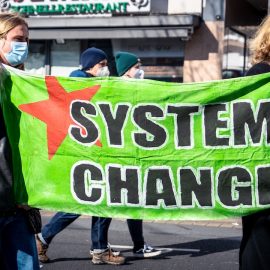

This article is an excerpt from the Shortform book guide to "The Power Elite" by C. Wright Mills. Shortform has the world's best summaries and analyses of books you should be reading.
Like this article? Sign up for a free trial here.
What’s the “executive class”? How did corporations in the United States get so powerful?
In The Power Elite, C. Wright Mills discusses how influential institutions came to control a majority of wealth and power in America. Corporations are one of the three main institutions where Mills believes the power elite developed. Mills explores the process by which their influence solidified over the years.
Read more to learn about the subtle rise of the corporate elite in America.
The Corporate Elite in America
Mills starts by discussing how an increasingly small number of corporations influence every aspect of life in America. The corporate elite that we have now is the result of a long process of centralization of wealth and power starting after the Civil War.
Step 1: Competing to Industrialize
In the decades following the Civil War, Mills says there was intense competition among American corporations. New technological developments like railroads and telegrams opened up crucial new markets by connecting formerly isolated towns and communities across the country—and corporations fought viciously for control over these markets. However, these competitions eventually had clear winners, as lax government regulation and corruption allowed larger corporations to buy up or force out smaller competitors. Corporate leaders during this period were the men who founded, expanded, and owned these companies. Examples include 19th-century industrialists like Andrew Carnegie, John D. Rockefeller, and J. P. Morgan, who created massive corporations that controlled the steel, oil, and banking industries respectively. As a consequence of these historical developments, writes Mills, the vast majority of any given industry in America is now controlled by five or fewer corporations.
| Bigger Is Better: Economies of Scale Why do industries tend to be dominated by a few large companies? Why do periods of relatively lax government regulation make this process easier? The answers to these questions have to do in part with economies of scale, or cost savings a company benefits from as it grows in size. The larger a company is, the more it produces—and the more it produces, the lower its costs are per unit produced. This allows large companies to keep prices lower than those of their smaller competitors, which often means smaller companies lose their customers and go out of business. For example, imagine two cookie companies: Big Cookie and Small Cookie. Both companies pay $1 million on fixed costs like cookie factories, research for new recipes, and salaries of managers and executives. Big Cookie produces 100,000 cookies per day, while Small Cookie produces 50,000 cookies per day. Therefore, Big Cookie only spends $10 on fixed costs per cookie, while Small Cookie spends $20 on fixed costs per cookie. In addition, Big Cookie can buy ingredients in bulk at a better deal than Small Cookie, meaning they spend less on ingredients per cookie. Because of their lower costs, Big Cookie can sell cookies cheaper than Small Cookie—eventually forcing Small Cookie to close. Government intervention can prevent this from happening by keeping businesses from growing too large or protecting smaller businesses. But, as previously stated, the decades after the American Civil War were notorious for lax regulations on business, meaning large businesses could dominate. |
Step 2: Shifting Leadership to Executives
Once industries were dominated by a few major corporations, the intense competition between them slowed down or even stopped altogether, explains Mills. He argues this was because of a shift in corporate leadership from founders to executives and stockholders. Unlike the founders of the past, this new “executive class” was less concerned with the success of their specific corporation and more concerned with the success of their industry and of corporate power in general. Mills suggests two reasons why this is the case:
1) Most executives don’t create or own a majority of their corporations—instead, they’re just hired to run them. This means they don’t have personal incentives to compete—they get paid whether their corporation grows, shrinks, or stays the same. They also own stock in many different companies, meaning their financial well-being isn’t tied to their specific corporation’s success.
2) In addition, executives work for multiple corporations over the course of their careers. This also disincentivizes competition—executives have no reason to compete with and potentially harm their future employers.
(Shortform note: In his earlier work White Collar, Mills claims this change in corporate structure and the subsequent growth of the “white collar” worker—salespeople, middle-managers, and so on—has contributed to a major cultural shift in middle-class America. Mills explains that new corporate structures and ideologies demand that people view each other as tools toward a specific end: Managers see their subordinates as tools for accomplishing tasks given by executives, while salespeople see the people around them as potential customers and therefore “instruments” of their own success. By viewing the people around them as means to an end, says Mills, people alienate themselves from genuine human connection and become isolated.)
Step 3: Defining American Life
Mills explains that, by working together toward their overall interests, the executive class and stockholders have consolidated their power and now dominate major portions of American life. While unforeseen circumstances (financial collapses, major world events, and so on) might cause individual companies or executives to lose power, the collective power and wealth of corporations remain very stable. They use this power to influence things like what people eat, where they live, the media they watch, and their political lives. An average individual, on the other hand, doesn’t have the wealth or influence to challenge corporate power in a significant way.
| Spanning the Globe Though Mills stresses the extent of corporate influence over American life, he doesn’t fully predict how large corporations would spread internationally. To understand why, let’s examine the world economy when The Power Elite was written—and how it’s changed since. In 1956, the global economy was for the most part divided into the communist and capitalist worlds. These countries didn’t trade with one another, creating two separate global economies at once. In addition, the process of decolonization was destabilizing the already fragile economies of many Western colonial empires—and also creating new nations, some of which became communist themselves. Therefore, while American corporations held influence or established a presence in other countries, they couldn’t exist all over the world the way they do now. But from the 1970s onward, many of the communist countries either reformed their economies to allow for global trade or collapsed altogether. With the fall of the Soviet Union, economic globalization skyrocketed and corporations—many of them American—were free to spread across the world. An iconic symbol of this process was the first McDonald’s restaurant opening in Russia in 1990 to a line of around 38,000 people. |

———End of Preview———
Like what you just read? Read the rest of the world's best book summary and analysis of C. Wright Mills's "The Power Elite" at Shortform.
Here's what you'll find in our full The Power Elite summary:
- How a group of corporate elite controls America's politics and economics
- How the elite exploit America's institutions for their own benefit
- A look at the dangers that arise when citizens feel powerless






